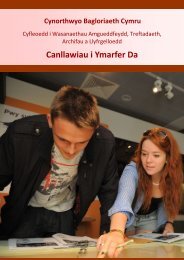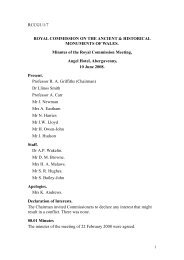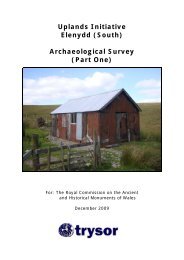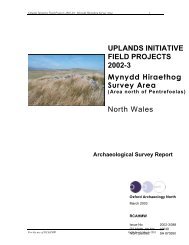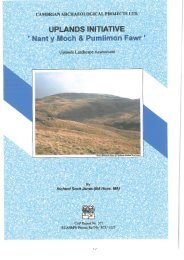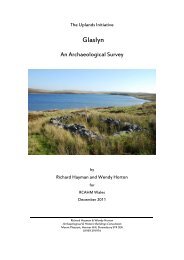Foel Goch Archaeological Survey - Royal Commission on the ...
Foel Goch Archaeological Survey - Royal Commission on the ...
Foel Goch Archaeological Survey - Royal Commission on the ...
You also want an ePaper? Increase the reach of your titles
YUMPU automatically turns print PDFs into web optimized ePapers that Google loves.
Uplands Initiative Field Projects 2011-12: <str<strong>on</strong>g>Foel</str<strong>on</strong>g> <str<strong>on</strong>g>Goch</str<strong>on</strong>g> <str<strong>on</strong>g>Survey</str<strong>on</strong>g> Report 20<br />
5.4 POST-MEDIEVAL/MODERN<br />
5.4.1 Agricultural Landscape and Settlement: in total, 136 sites have been ascribed to<br />
<strong>the</strong> post-medieval and modern periods, and form <strong>the</strong> majority of <strong>the</strong> identified sites<br />
(Table 1). The sites reflect <strong>the</strong> relatively recent exploitati<strong>on</strong> of large tracts of<br />
moorland. The land is ei<strong>the</strong>r currently open moorland comm<strong>on</strong>, gradually improved<br />
moorland enclosed by Enclosure Act, or small areas of agricultural fringe lands<br />
located adjacent to farms within Pentre-tai-yn-y-cwm or surrounding Cefn Caer<br />
Euni. The farmstead of Eglwys-Anne is <strong>the</strong> <strong>on</strong>ly definitive permanently occupied site<br />
within <strong>the</strong> study area (NMR 519240; Plate 13); it c<strong>on</strong>sists of a single ruinous range<br />
including a farmhouse and attached barn, and has an area of enclosed cultivati<strong>on</strong> <strong>on</strong><br />
<strong>the</strong> south side and some associated peat cuttings (NMR 519244-519245 and NMR<br />
519285). The surrounding ffridd enclosures are called Eglwys-Anne Warren Ffridd<br />
and historically this area, (al<strong>on</strong>g with land outside <strong>the</strong> study area to <strong>the</strong> west) was<br />
<strong>the</strong> site of a warren, and <strong>the</strong> land is still tenanted by <strong>the</strong> Rhiwlas estate. Two o<strong>the</strong>r<br />
potentially domestic structures were recorded in <strong>the</strong> study area both located <strong>on</strong> <strong>the</strong><br />
upland edge of enclosed land. The first site, a platformed structure, is located at<br />
Nant Cefn Coch (NMR 519202) and has been built-over with a sheepfold. There is<br />
an area of peat cutting not too distant from it <strong>on</strong> <strong>the</strong> east flank of Moel Emoel<br />
(NMR 519203). The sec<strong>on</strong>d site is a rectangular enclosure at Waen Fawr <strong>on</strong> <strong>the</strong><br />
sou<strong>the</strong>rn flank of Cefn Caer Euni (NMR 412788). The enclosure has a disturbed<br />
central area that may have c<strong>on</strong>tained a cottage that could have functi<strong>on</strong>ed as a Ty<br />
Unnos (a small squatters cottage).<br />
5.4.2 Many sites relate to <strong>the</strong> extensive moorland sheep walks, and comprise disparate<br />
sheepfolds, sheep shelters and shepherd’s shelters (up to 37 examples) scattered<br />
widely across <strong>the</strong> whole study area. The number of <strong>the</strong>se identified structures was<br />
relatively low when compared with <strong>the</strong> wider regi<strong>on</strong> (OA North 2009; OA North<br />
2010b), but still dem<strong>on</strong>strate that sheep farming, and to some extent cattle farming,<br />
have been a major enterprise across <strong>the</strong> moorland at altitude during <strong>the</strong> postmedieval<br />
period. The sheepfolds are located <strong>on</strong> <strong>the</strong> open comm<strong>on</strong>, for <strong>the</strong> most part<br />
ei<strong>the</strong>r hugging <strong>the</strong> sheltered cwms <strong>on</strong> <strong>the</strong> streams running off of <strong>the</strong> mountains (eg<br />
in Cwm Da) or are located adjacent to moorland trackways (eg <strong>on</strong> Garnedd Fawr -<br />
NMR 519190; Plate 14). The trackways can be found radiating in all directi<strong>on</strong>s<br />
giving access up <strong>on</strong>to <strong>the</strong> sheepwalks and will have also formed l<strong>on</strong>g-distance routes<br />
over <strong>the</strong> mountains between communities in different valleys. A series of stock<br />
enclosures have been identified, with potentially early examples being associated<br />
with possible transhumant domestic sites (Secti<strong>on</strong> 5.3.2). Fur<strong>the</strong>r slightly larger<br />
examples were located <strong>on</strong> <strong>the</strong> east flank of Craig Wenallt and Bryn Bras in <strong>the</strong> east<br />
of <strong>the</strong> study area (NMR 519266 and NMR 519268; Plate15). The latter site<br />
c<strong>on</strong>tained a sheepfold but it is just possible that such structures could have formed<br />
small squatter settlements.<br />
5.4.3 Industrial Landscape: <strong>the</strong> evidence for industrial activity is limited within <strong>the</strong> study<br />
area. There are disparate examples of nine small-scale quarries located within <strong>the</strong><br />
study area, all of which, except <strong>on</strong>e, are associated with small-scale, localised<br />
extracti<strong>on</strong> for enclosure wall c<strong>on</strong>structi<strong>on</strong>. The o<strong>the</strong>r quarry was used to c<strong>on</strong>struct a<br />
marker cairn/trig<strong>on</strong>ometric point <strong>on</strong> Moel Emoel (NMR 519210-519211). Similarly,<br />
surviving evidence for peat cutting is <strong>on</strong> a small-scale within <strong>the</strong> study area and<br />
For <strong>the</strong> use of RCAHMW © OA North: February 2012




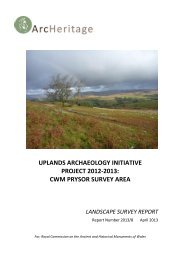
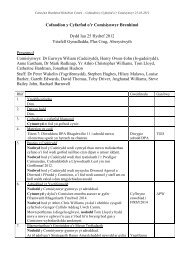
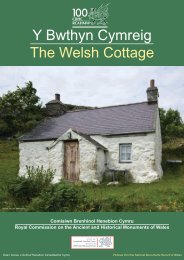

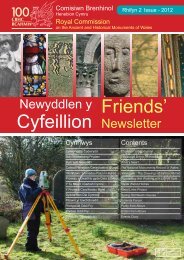
![The Source of the Usk Walk [2012 PDF]](https://img.yumpu.com/49285699/1/190x245/the-source-of-the-usk-walk-2012-pdf.jpg?quality=85)

